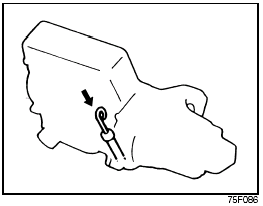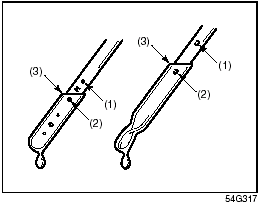Automatic Transaxle Fluid
Specified Fluid
Use an automatic transaxle fluid equivalent to DEXRON®-III.
Fluid Level Check
CAUTION:
Driving with too much or too little
fluid can damage the transaxle.
You must check the fluid level with the automatic transaxle fluid at normal operating temperature.
To check the fluid level: 1) To warm up the transaxle fluid, drive the vehicle or idle the engine until the temperature gauge indicates normal operating temperature.
2) Then drive for ten more minutes.
NOTE:
Do not check the fluid level if you have just
driven the vehicle for a long time at high
speed, or if you have driven in city traffic in
hot weather. Wait until the fluid cools down
(about 30 minutes), or the fluid level indication
will not be correct.
3) Park your vehicle on level ground.
4) Apply the parking brake and then start the engine in “P” (Park). Let it idle for two minutes and keep it running during the fluid level check.
5) With your foot on the brake pedal, move the gearshift lever through each gear, pausing for about three seconds in each range. Then move it back to the “P” (Park) position.

WARNING:
Be sure to depress the brake pedal
when moving the gearshift lever, or
the vehicle can move suddenly.


(1) FULL
(2) LOW
(3) The lowest point = Fluid level
6) The handle of the A/T fluid dipstick is colored red for easy identification.
Remove the dipstick, clean it and push it back in until the cap seats. Pull out the dipstick and read the fluid level.
The fluid level should be between the two marks in the “HOT” range on the dipstick.
7) Add just enough specified fluid through the dipstick hole to fill the transaxle to the proper level. It takes only 0.4 liters (0.85 US pt) for 4-speed automatic transaxle to raise the level from “LOW” to “FULL”.
CAUTION:
After checking or adding oil, be sure
to insert the dipstick securely.
Changing Oil
Since special procedures, materials and tools are required to change the automatic transaxle oil, it is recommended that you trust this job to your authorized SUZUKI dealer.
See also:
2010 Suzuki SX4 review By Bill Jackson
The 2010 Suzuki SX4 SportBack has decent handling, but it's not the car to
bring to the drag strip if you want to win anything — even if it is supposed to
be the performance version of Suzuki's ...
Towing a Disabled Vehicle
Emergency Towing
If your vehicle is disabled, it may be towed
by a tow truck using one of the following
methods:
1) Tow the vehicle with two wheels lifted
by the tow truck and the other two
whee ...
Fuel Filler Cap
SX4
SX4 SEDAN
The fuel filler cap is located on the left rear
side of the vehicle. The fuel filler door can
be unlocked by pulling up the opener lever
located on the outboard side of the ...
